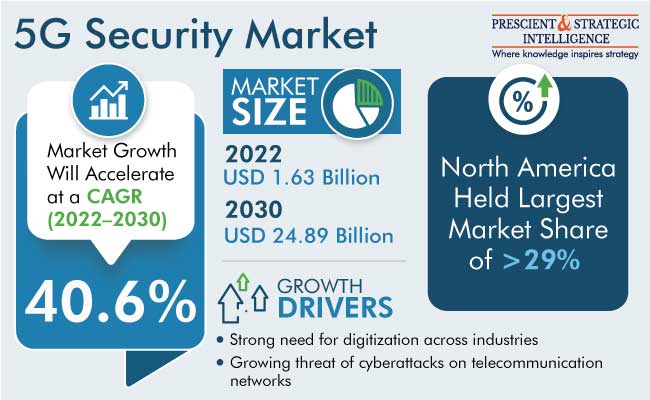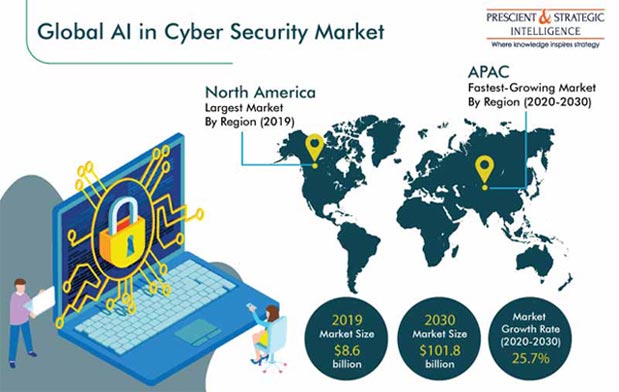5G Security Market is Dominated by North America
As per a statement by P&S Intelligence, the 5G security market generated a value of USD 1.63 billion in 2022, and it will propel at a 40.60% CAGR, to touch USD 24.89 billion, by 2030.
The growth in the industry is mainly ascribed to the growing requirement for fast network connection and the mounting concern about security for 5G networks because of the increasing attacks on them.
Additionally, growth opportunities will rise due to the requirement for private 5G networks in the government, industrial, and businesses sector, along with the increasing operator investments in dynamic infrastructure.
The services category will witness faster growth over this decade, at a rate of approximately 41.2%. The requirement for service between end users has grown with the developing technological trends.
In 2022, the 5G NR non-standalone architecture category held a share of over 64.0%.
Whereas, the standalone 5G category will gain more traction in the years to come. This is credited to the fact that more than offering a higher capacity, it also provides Ultrareliable Low Latency Communications.
Based on deployment, in 2022, the cloud category accounted for the larger 5G security market share, of 69%, and it is also expected to be the fastest growing, growing at a rate of 42%. This is mainly ascribed to the low cost of the cloud, particularly for small and medium-sized enterprises.
North America dominated the 5G security industry, owing to the significant developments of 5G technology and the implementation of security measures to prevent leaks. Spectra for the fifth generation are being disseminated successfully across North America, in both the low-band and high-band ranges.
The U.S. is expected to witness a strong growth rate in the North American Industry, growing at a rate of approximately 40%, in the years to come. The fifth-generation security approach offers a more effective means to address improvements in the network, therefore rising the technological ability of the nation to develop and contribute.
APAC is the second-fastest growing industry in the global 5G security industry, owing to the large mobile subscriber pool, due to its large population.
Moreover, APAC is home to the most users of mobile in the world, and the nations in this region will keep increasing their telecom networks in the years to come. The strategic leadership, economic diversity, and size of countries, for instance, China, Singapore, Australia, Japan, and South Korea will be the main reasons for the growth of the industry.
Hence, with the robust requirement for digitization across industries and the increasing threats of cyberattacks on telecommunication networks, the 5G security industry will grow significantly in the years to come.
Read More: https://www.psmarketresearch.com/market-analysis/5g-security-market-report
As per a statement by P&S Intelligence, the 5G security market generated a value of USD 1.63 billion in 2022, and it will propel at a 40.60% CAGR, to touch USD 24.89 billion, by 2030.
The growth in the industry is mainly ascribed to the growing requirement for fast network connection and the mounting concern about security for 5G networks because of the increasing attacks on them.
Additionally, growth opportunities will rise due to the requirement for private 5G networks in the government, industrial, and businesses sector, along with the increasing operator investments in dynamic infrastructure.
The services category will witness faster growth over this decade, at a rate of approximately 41.2%. The requirement for service between end users has grown with the developing technological trends.
In 2022, the 5G NR non-standalone architecture category held a share of over 64.0%.
Whereas, the standalone 5G category will gain more traction in the years to come. This is credited to the fact that more than offering a higher capacity, it also provides Ultrareliable Low Latency Communications.
Based on deployment, in 2022, the cloud category accounted for the larger 5G security market share, of 69%, and it is also expected to be the fastest growing, growing at a rate of 42%. This is mainly ascribed to the low cost of the cloud, particularly for small and medium-sized enterprises.
North America dominated the 5G security industry, owing to the significant developments of 5G technology and the implementation of security measures to prevent leaks. Spectra for the fifth generation are being disseminated successfully across North America, in both the low-band and high-band ranges.
The U.S. is expected to witness a strong growth rate in the North American Industry, growing at a rate of approximately 40%, in the years to come. The fifth-generation security approach offers a more effective means to address improvements in the network, therefore rising the technological ability of the nation to develop and contribute.
APAC is the second-fastest growing industry in the global 5G security industry, owing to the large mobile subscriber pool, due to its large population.
Moreover, APAC is home to the most users of mobile in the world, and the nations in this region will keep increasing their telecom networks in the years to come. The strategic leadership, economic diversity, and size of countries, for instance, China, Singapore, Australia, Japan, and South Korea will be the main reasons for the growth of the industry.
Hence, with the robust requirement for digitization across industries and the increasing threats of cyberattacks on telecommunication networks, the 5G security industry will grow significantly in the years to come.
Read More: https://www.psmarketresearch.com/market-analysis/5g-security-market-report
5G Security Market is Dominated by North America
As per a statement by P&S Intelligence, the 5G security market generated a value of USD 1.63 billion in 2022, and it will propel at a 40.60% CAGR, to touch USD 24.89 billion, by 2030.
The growth in the industry is mainly ascribed to the growing requirement for fast network connection and the mounting concern about security for 5G networks because of the increasing attacks on them.
Additionally, growth opportunities will rise due to the requirement for private 5G networks in the government, industrial, and businesses sector, along with the increasing operator investments in dynamic infrastructure.
The services category will witness faster growth over this decade, at a rate of approximately 41.2%. The requirement for service between end users has grown with the developing technological trends.
In 2022, the 5G NR non-standalone architecture category held a share of over 64.0%.
Whereas, the standalone 5G category will gain more traction in the years to come. This is credited to the fact that more than offering a higher capacity, it also provides Ultrareliable Low Latency Communications.
Based on deployment, in 2022, the cloud category accounted for the larger 5G security market share, of 69%, and it is also expected to be the fastest growing, growing at a rate of 42%. This is mainly ascribed to the low cost of the cloud, particularly for small and medium-sized enterprises.
North America dominated the 5G security industry, owing to the significant developments of 5G technology and the implementation of security measures to prevent leaks. Spectra for the fifth generation are being disseminated successfully across North America, in both the low-band and high-band ranges.
The U.S. is expected to witness a strong growth rate in the North American Industry, growing at a rate of approximately 40%, in the years to come. The fifth-generation security approach offers a more effective means to address improvements in the network, therefore rising the technological ability of the nation to develop and contribute.
APAC is the second-fastest growing industry in the global 5G security industry, owing to the large mobile subscriber pool, due to its large population.
Moreover, APAC is home to the most users of mobile in the world, and the nations in this region will keep increasing their telecom networks in the years to come. The strategic leadership, economic diversity, and size of countries, for instance, China, Singapore, Australia, Japan, and South Korea will be the main reasons for the growth of the industry.
Hence, with the robust requirement for digitization across industries and the increasing threats of cyberattacks on telecommunication networks, the 5G security industry will grow significantly in the years to come.
Read More: https://www.psmarketresearch.com/market-analysis/5g-security-market-report
0 Comments
0 Shares
0 Reviews





